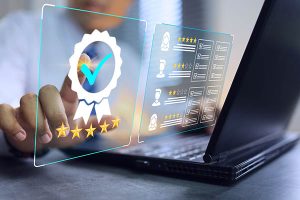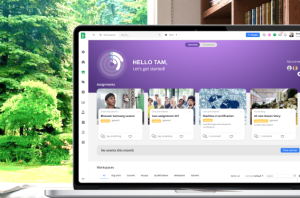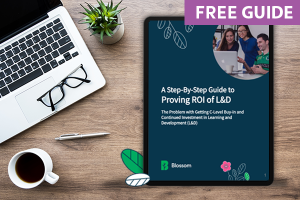There’s little doubt that the future of work has undergone significant changes. And it certainly looks like we will see continued disruption in how we work, with advancements in technology, remote work becoming more prevalent, and a growing emphasis on skills-based organisations.
Embracing these changes and proactively adapting your learning and development (L&D) programmes will be crucial to stay competitive. And those businesses that proactively adjust their L&D strategies will be better positioned to thrive in this new era.
Learn tips and strategies that help L&D teams train and manage remote workers. This article will help you optimise your training programmes for virtual environments and build a democratic learning environment for your distributed team.
Remote workers: the story so far
Reflecting on the COVID-19 pandemic, organisations needed to transform their L&D efforts almost overnight.
With the sudden transition to remote work, employees and organisations faced new challenges and demands, needing employers to implement effective strategies to ensure continuous learning and skill development. This accelerated need to reevaluate and enhance remote workforce L&D practices resulted in a huge shift towards more agile, technology-driven, and personalised approaches to training.
That said, the urgency to adapt to remote work realities often led to hastily implemented strategies, resulting in challenges for both employees and organisations.
Quick implementation compromised the quality of some L&D initiatives. This rushed development resulted in suboptimal training content, lacking the depth and effectiveness needed for meaningful skill development.
Secondly, the quick introduction of new tools and technologies, such as online meeting software, overwhelmed some employees. Steep learning curves associated with hastily adopted digital platforms caused stress and reduced engagement among remote workers.
Thirdly, the need for speed hindered the personalisation of learning experiences. Tailoring training to individual needs is crucial, and a rushed approach often results in one-size-fits-all solutions that do not address specific employee requirements. The pressure to quickly upskill and reskill employees contributed to increased stress and burnout.
Finally, quick implementation limited the ability to assess the effectiveness of L&D programmes. The lack of skills inference hindered how businesses understood the real impact of training on remote workers’ skill development.
Use this article to press the reset button.
Learn some of the best practices for training and managing remote workers. Adapt your L&D programmes to the unique challenges of remote work and discover strategies to optimise training initiatives.
Remote workforce best practices
Best practices provide a consistent framework for managing and training remote workers, ensuring everyone follows standardised processes and procedures.
Since remote employees might be working across different time zones, implementing best practices ensures that remote work processes are streamlined, increasing efficiency and productivity among off-site staff.
Optimise L&D resources by offering a structured approach to training guided by best practices, such as:
- Setting clear expectations. Define goals, tasks, and deadlines to ensure remote workers understand their responsibilities and manage their time well.
- Aligning L&D programmes with job roles. By tailoring training to match the specific requirements of each job role, off-site employees receive training that directly relates to the tasks and responsibilities they perform in their positions.
- Maintaining clear communication. Nearly half of workers report their productivity being affected by poor communication. Establish transparent and frequent communication channels to keep remote employees informed about expectations, updates, and changes.
- Reviewing remote work policies. When did you last check your remote work policies? If they were created during the pandemic, it’s time to review them. Ensure alignment with your organisation by reviewing policies like flexible working and data protection.
- Offering tech support when needed. A Gartner survey of L&D professionals found that 50% to 60% of respondents reported their workforce had to use new skills in response to the COVID-19 pandemic. This highlights the importance of offering training programs and ensuring that employees have the necessary tech support and resources to learn new skills effectively.
Adapt your L&D programme for remote workers
Remote workers, like any employees, seek career growth and development opportunities. Adapting elements of your L&D strategy for remote workers ensures that training content is accessible and relevant to employees in diverse locations. Here’s how.
1. Create social connections
Research upon research shows that connecting with others transforms the workplace from a task-oriented site to a community where individuals thrive through meaningful relationships, shared goals, and mutual support.
When L&D teams provide their employees with a range of collaboration tools and opportunities, it further enhances the sense of community in the workplace.
Let’s put that into perspective and say an IT company offers collaboration tools, including virtual team spaces, instant messaging platforms, and regular video conferencing opportunities for all employees working remotely.
These collaboration tools allow employees to communicate, share ideas, and provide project updates seamlessly. This has improved communication channels compared to relying solely on email or traditional meetings.
Plus, regular video conferencing sessions for work and casual virtual gatherings can boost employee engagement. As team members feel more connected to their colleagues, even if they are working remotely, your workplace can become a more vibrant and inclusive environment. And highly engaged employees drive 18% more revenue.
Blossom has comprehensive features to help off-site employees maintain human connections. Give your people the tools they need to feel connected and engaged, no matter their location, role, seniority, or place of work.
Empower remote learners to enhance skills, communication, and collaboration across teams and locations with a dedicated knowledge centre. Create and centralise knowledge resources for easy access, linking, and sharing within defined user groups.
Connect and engage employees at every level with customisable employee portals, networking, and communication tools that boost individual and cross-functional engagement.
“Blossom has changed the way we learn – it has elevated our capabilities to share our knowledge and qualify our mentors and employees. It has also organised their method of learning and appetite for learning. It has had a positive impact on every user in the organisation.”
Liat Segal, HR Manager and Manager of Learning at PERACH
2. Consider learning within the flow of work
A phrase that has become more popular, learning in the flow of work means seamlessly integrating continuous, personalised learning into daily tasks. The approach recognises that learning is an ongoing part of everyday work and uses technology to deliver learning content through familiar tools and platforms.
Why is this important?
Well, because it ensures that employees can acquire new skills and knowledge right when they need them during their regular work activities–making learning more practical, relevant, and accessible,
“There’s no point going to training if you don’t build the right skills; there’s no point building a skill if you can’t apply it on the job; and there’s no point creating a capability unless it can help you grow, expand, and do new things. That’s what’s going on – we’re stretching the role of L&D to focus on growth, not just learning.”
Josh Bersin
Prioritise employee growth beyond just learning. Focus your L&D programmes on developing practical skills for daily tasks, ensuring that remote employees can apply what they learn. Present real-life stories and case studies relevant to employees’ roles, encouraging them to analyse situations and propose solutions. Use realistic online simulations to simulate job scenarios and allow remote employees to apply their skills in a virtual environment.
These methods empower remote teams not just to succeed in their current roles but also to innovate effectively.
3. Offer blended learning
Restrictive and inflexible learning activities are among the top 10 barriers to learning that L&D Managers face.
While it may be tempting to offer solely online learning to remote workers, providing a mix of online learning and instructor-led training (ILT) is essential.
Blended learning is a practical and tactical approach to employee training and development. It combines traditional in-person training with online learning methods to create a flexible learning experience.
While some remote workers may thrive in self-paced online courses, others may benefit more from interactive discussions and guidance provided in ILT sessions.
ILT allows for real-time engagement, interaction, and immediate clarification of doubts. This personal touch can enhance understanding and maintain interest, which might be challenging to achieve online.
What’s more, some subjects or skills are intricate and need hands-on guidance. Instructor-led sessions help explain complex concepts, foster discussions, and guide knowledge’s practical use, ensuring a better understanding.
By contrast, online learning offers greater flexibility. Remote employees can access educational content at their own pace and convenience. They can choose when and where to engage with the materials, accommodating varying work schedules, time zones, and personal preferences–promoting a self-directed learning approach.
Adapt your L&D programme by offering a blended learning approach for flexibility and adaptability. Give remote workers access to pre-recorded materials to learn at their own pace and then allow them to participate in live sessions for discussions, practice, or additional guidance. This blend accommodates different schedules and time zones.
4. Support employee well being
The latest numbers on employee health and well-being are staggering. 9 in 10 UK adults experienced high or extreme stress in the past year, and 1 in 5 workers hit burning point.
Why?
Two big reasons: first, the fast-paced nature of modern work and the constant demand for productivity create a high-stress environment. The pressure to meet tight deadlines, achieve targets, and adapt to changing circumstances elevates stress levels among employees.
Second, blurred boundaries between work and personal life and constant connectivity make it challenging for individuals to disconnect from work, leading to increased stress and burnout.
By adapting your L&D programme to support the health and well-being of remote employees, you can address the root causes of workplace stress and burnout and maintain a healthy work environment.
Provide resources, training, and support focusing on stress management, work-life balance, and mental health. Use employee performance reviews to identify strengths and weaknesses and chat through personal and professional priorities.
Implement tools to enable managers and remote teams to schedule regular one-on-one check-ins to discuss progress, address concerns, and maintain a strong connection. Goal-setting features from Blossom allow managers and off-site workers to align on objectives.
Get actionable data for collaborative discussion and plan the next steps to improving employee health, well-being, and performance.
5. Promote diversity and inclusion
Did you know that the UK has some of the highest levels of inequality in Europe? According to research, over 8 million employees in the UK feel they’ve been discriminated against because of their gender alone.
Remote teams often have individuals with diverse backgrounds, skills, and abilities. Inclusive L&D programmes cater to this diversity, fostering a supportive environment where everyone feels valued and can contribute effectively.
Also, adhering to inclusive practices for L&D ensures compliance with legal requirements and regulations regarding accessibility and equal opportunities. This protects your business from legal risks and demonstrates a commitment to ethical business practices.
Make sure your L&D programmes promote diversity and inclusion by:
- Including a diverse group of trainers and facilitators to lead learning sessions
- Ensuring all learning platforms and materials are accessible to employees with different abilities (Cue Blossom!)
- Developing Employee Resource Groups that bring together remote employees with shared characteristics or interests
Adapt programmes for remote workforce learning
Recognise the unique challenges and opportunities of a virtual workforce. Address them by implementing tailored learning solutions that meet the specific needs of remote teams, empowering employees to thrive.
By having a flexible and adaptive approach to L&D, you can ensure your remote employees have the skills to perform their roles now and in the future.
Tailor your L&D programmes for a remote and hybrid workforce with Blossom. Schedule a demo with one of our friendly experts today.








